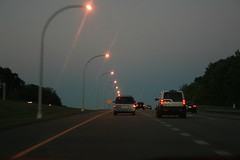 The area where is live is laced with an extensive system of concrete culverts designed to channel rain water. Shown here is the Verdugo Wash. These culverts lead to the Los Angeles River, which is partially restored but mostly a concrete culvert as well, and then to the ocean.
The area where is live is laced with an extensive system of concrete culverts designed to channel rain water. Shown here is the Verdugo Wash. These culverts lead to the Los Angeles River, which is partially restored but mostly a concrete culvert as well, and then to the ocean.Up above, at the base of the 5000 foot high steep wall of the San Gabriels sit huge boulder fields with concrete dams designed to trap the boulders that are washed down from the mountains in a heavy rain. Around our house the earth is a sandy loam with dozens of grey rocks of various sizes embedded in it. All of this is evidence of the thousands of years of periodic floods that were the harsh, natural environment of this area that lies in a valley just above the LA basin.

I was reminded of this history by an article this morning in the Los Angeles Times about the Great Montrose Flood of 1934. About a dozen people died when a wall of water, mud, and boulders came crashing down out of Pickens Canyon on New Year's Eve. It's hard to imagine the violence that such a flood would have represented. The San Gabriels are steep and rocky, and the kinetic energy represented by the flow of water and earth must have been staggering. Sometimes we sneer at our concrete "washes" in LA - they seem like such a crude substitute for the natural arroyos that existed before - but another way to look at them is as a triumph of civil engineering that lets human beings live safely in a harsh environment.









